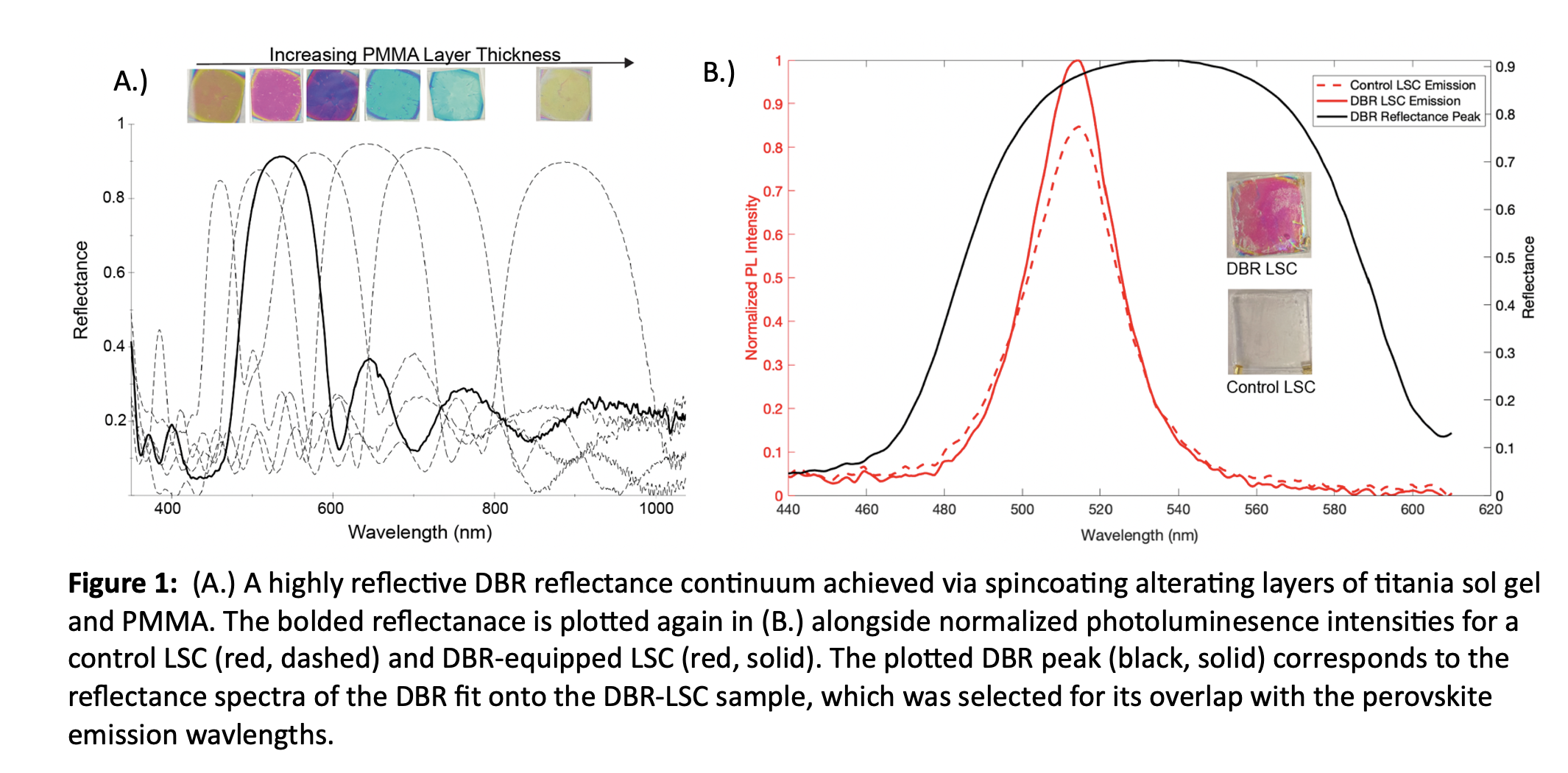To meet surging energy demands of global society, namely an anticipated 50% increase in world energy consumption by the year 2050, the need for inexpensive renewable energy sources has become clear [1]. Luminescent Solar Concentrators (LSCs) are low-cost photonic devices with the potential to vastly improve solar panel power production. In their simplest form, LSCs are rectangular slabs (typically polymer or glass) that are doped with photoluminescent materials. These devices are able to collect sunlight over large areas using these luminophores, and concentrate the photoluminescent emission onto the thin edges of the slabs which can then be collected by solar cells [2], [3]. While in theory LSCs are able to attain concentration factors on the order of 46,000x, the synthetic record to date is only 30.3x, achieved by equipping an LSC with spectrally-selective photonic mirrors to enhance photoluminescent trapping [4].
Here, we discuss an entirely solution-processed LSC architecture that is designed to leverage the extraordinary properties of Cesium Lead Bromide (CsPbBr3) perovskites for high efficiency concentrators. These LSCs are created by curing 10nm CsPbBr3 perovskite nanocubes, formed through an in-air synthesis at room temperature, into thin (0.1-0.3mm) matrices of polydimethylsiloxane (PDMS) between glass slides. The perovskites emit isotropically in the host matrix, and the refractive index contrast between PDMS (n = 1.4) and air (n = 1) yields total internal reflection (TIR) for all photon emission angles greater than θcrit = 45.6º. The resulting escape cone loss for the LSC for non-TIR modes is a minimum of 30%. To reduce escape cone losses and improve the trapping efficiency of the LSC, Distributed Bragg Reflectors (DBRs) are spincoated onto the outside faces of the glass slides to “sandwich” the perovskite-PDMS matrix. The DBRs are created through alternative spincoating of high refractive index titania sol gel (d = 85nm) and low refractive index PMMA (d = 34-180nm), with the layer thicknesses quantified through atomic force microscopy. Each DBR is composed of 15 total layers for reflectivities ≥ 90%, where the characteristic PMMA thickness in a given stack is constant but this value can change across stacks. In this way the reflectance peak can be tuned throughout the visible spectrum as seen in Figure 1A. Utilizing an optical characterization setup fit with a high-power 405nm laser and a spectrometer, emission intensity at the edge of the LSC was quantified for the control and DBR-fitted perovskite LSCs. Preliminary data shows a raw emission signal increase of approximately 15% when DBRs with reflectances that overlap with perovskite emission wavelengths are present in the architecture (Figure 1B.) This corresponds to a 25% increase in trapping efficiency when normalized by absorbance data. This agrees with Monte Carlo Ray Tracing simulations, which also indicate that by further optimizing this system concentration factors that surpass 30.3x are possible. Through this work we have demonstrated the chemical compatibility of typically unstable lead halide perovskites in entirely solution-processed, solid-phase LSCs environments, and the ability to bolster their trapping efficiency through the addition of spectrally-selective DBR mirrors.
References
[1] “Five Ways to Jumpstart the Renewable Energy Transition Now,” The United Nations. Accessed: Oct. 06, 2022. [Online]. Available: https://www.un.org/en/climatechange/raising-ambition/renewable-energy-t…
[2] H. C. Bauser et al., “Photonic Crystal Waveguides for >90% Light Trapping Efficiency in Luminescent Solar Concentrators,” ACS Photonics, vol. 7, no. 8, pp. 2122–2131, Aug. 2020, doi: 10.1021/acsphotonics.0c00593.
[3] L. Xu, Y. Yao, N. D. Bronstein, L. Li, A. P. Alivisatos, and R. G. Nuzzo, “Enhanced Photon Collection in Luminescent Solar Concentrators with Distributed Bragg Reflectors,” ACS Photonics, vol. 3, no. 2, pp. 278–285, Feb. 2016, doi: 10.1021/acsphotonics.5b00630.
[4] N. D. Bronstein et al., “Quantum Dot Luminescent Concentrator Cavity Exhibiting 30-fold Concentration,” ACS Photonics, vol. 2, no. 11, pp. 1576–1583, Nov. 2015, doi: 10.1021/acsphotonics.5b00334.


